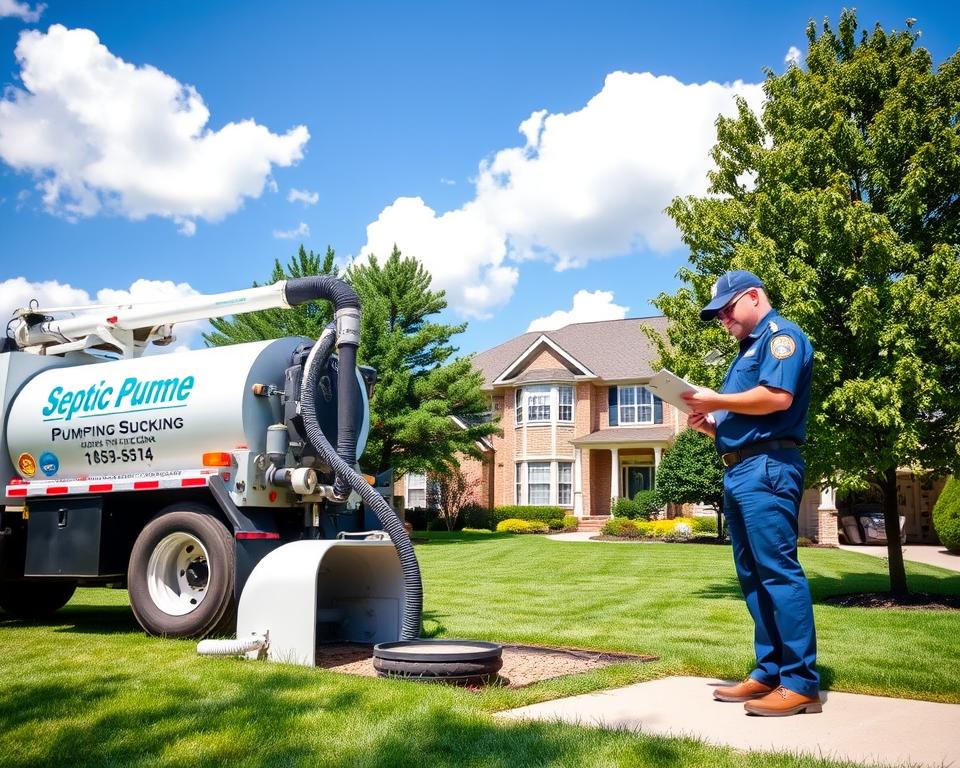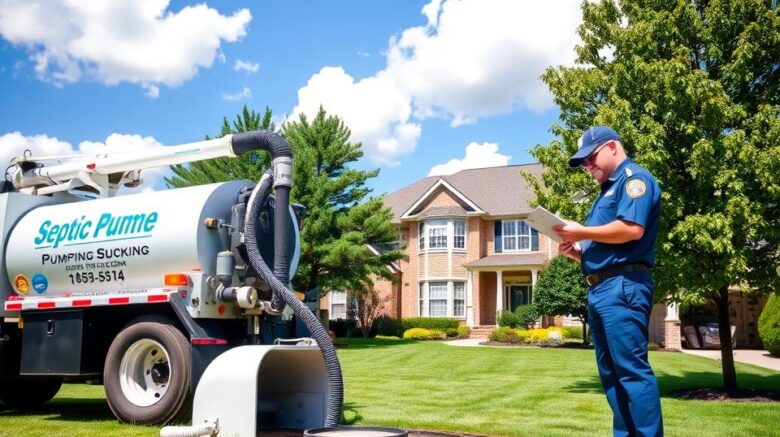Septic Tank Pumping Fees
Have you thought about the true expense of keeping your septic system up to date, or if you’re shelling out more than necessary? It’s vital for property owners to comprehend the specifics of septic tank pumping prices. On average, the fee hovers around $420, however it can fluctuate significantly. This difference results from factors like your system’s volume and geographic area – septic tank cleaning service.
Regular upkeep of your septic tank wards off hefty repairs, underscoring the importance of knowing service costs. We aim to dive into septic tank service pricing in depth. This will help you plan money‑wise for your system’s upkeep.
Core Messages
- Average septic tank pumping runs about $420.
- Prices can range between $290 and $560 USD subject to various conditions.
- Regular upkeep helps avoid more expensive repairs down the line.
- Most households call for pumping every three to five years.
- Household size and water usage can influence pumping schedule.
Grasping the Importance of Septic Tank Pumping
Septic tank pumping is crucial for a efficient wastewater system. It removes solids that, if not addressed, cause blockages. Consistent pumping doesn’t just avoids bad smells but also fends off steep repair costs.
Ignoring septic tank maintenance can compromise our common dependence on these systems. Luckily, affordable services reduce the risk of system failure. Scheduled upkeep prolongs your septic system’s life, helping maintain efficient operation.
Pricing for septic tank upkeep illustrates the value of proactive care. Regular service detects problems early, heading off severe damage and steep repair bills. Regular pumping is a prudent move for homeowners to secure their investment and ensure peace of mind.
Average Costs for Septic Tank Pumping
Septic tank pumping commonly falls between $250 USD and $600 in cost. In most cases, homeowners will spend about $400 for this necessary service. Cost swings are due to factors like capacity, property location, and how often service is performed. Common tanks, around 1,000 gallons, usually cost between $225 and $400.
Homeowners should remember the importance of allocating funds every 3 to 5 years for septic tank cleaning. This regular care is based on the tank’s usage and size. It helps avert more serious, costlier issues down the road, showing to be both labor and budget friendly.

Factors Influencing Septic Tank Pumping Prices
Several factors are key in establishing the price of septic tank pumping. Understanding these details helps homeowners to plan for these required services properly.
The capacity is significant greatly. Larger tanks demand more effort and materials to empty, which means elevated fees. The accessibility to your tank also noticeably affects the price. Tanks installed deeply or in hard‑to‑reach locations necessitate more time and specialized equipment from technicians, thus raising the labor costs.
Costs can differ widely depending on where you live. This is due to differences in local labor rates and disposal fees. For example, some areas have higher charges for removing waste, affecting the total service cost. Moreover, tanks with significant solid waste accumulation also see additional fees—anywhere from $100 USD to $300. Plus, the more frequently a tank requires pumping—due to higher household wastewater production—the higher the ongoing expenses.
Septic Tank Size and Its Influence on Cost
The volume of your septic tank directly influences the cost of its upkeep. Lower‑capacity tanks, for example, those that can hold three‑quarters of a thousand gallons, generally have lower pumping costs, usually ranging from $175 to $300. On the other hand, higher‑capacity tanks, capable of holding up to 1,750 gallons, may incur charges between $400 and $700. The majority of single‑family residences use tanks that hold between 1,000 to twelve‑fifty gallons, delivering a balance between volume and performance.
Households with smaller tanks or large households often require more frequent pumping services, which improves the overall expense. It’s crucial to schedule regular septic tank inspections in these situations. This makes sure the tank does not overflow or break down, which helps avoid additional damages. By comprehending the link between tank size and service fees, homeowners can take well‑informed choices regarding their septic systems and their upkeep demands.
Geographic Variations in Septic Tank Pumping Costs
Septic tank pumping costs can vary substantially based on region. In urban areas, the expenses are often higher due to local septic services experiencing increased overhead. For example, Minneapolis, MN residents may spend between $180 and $280, while those in Portland, OR could see prices from $440 to $750 USD.
The reasons behind these gaps are many. They include regional expenses, need for septic specialists, and local regulations. In places where septic services are limited, homeowners might incur higher charges due to the lack of options. Moreover, stringent regulations in some regions can push up the need for higher compliance fees, influencing the cost of services.
Understanding about these geographic cost variances is important for homeowners. It allows them to plan their septic maintenance spending more accurately. By understanding local pricing, they can obtain quotes from specialists prudently, caring for their septic system efficiently without overspending.
Additional Costs to Consider with Septic Tank Pumping
Homeowners often forget about various additional maintenance costs linked to septic tank pumping. The core cost includes just the standard service, leaving out other potential expenses. Understanding these can aid in creating a comprehensive budget.
Video line checks, for instance, fall between $250 USD to $500. They offer a no‑dig look into the system’s condition. Additionally, cleaning filters, which if ignored can lead to system failures, represents another cost.
The window for repairs can be large, from $100 to $4,000, according to the specific issues. This range underscores the necessity of factoring in additional maintenance costs for future budgeting.
Planning for Septic Tank Maintenance
When setting funds aside for septic tank upkeep, it’s important to embrace a holistic view. This incorporates several critical elements. Due to variable factors, the cost of maintenance can vary considerably. Therefore, smart financial planning is key.
To ensure your system operates smoothly and to sidestep unexpected bills, keep these intervals and services in mind:
- Scheduled pumping: This service is generally required every 3 to 5 years.
- Inspections: Set aside for around $250 USD to $1,180 for inspections every three years.
- Potential repairs: Maintain a fund for unexpected fixes, which can pop up unexpectedly.
Setting up a regular maintenance calendar with a dependable septic service is crucial. By expecting these expenses, homeowners can avoid the hefty costs tied to neglect. This strategy secures the life span and effectiveness of their septic systems.
Common Signs That Your Septic Tank Needs Pumping
Remaining vigilant to your septic system’s condition is crucial. Spot the initial signs that suggest your septic tank is due for pumping. Doing so can avoid significant damage and cut repair costs.
- Slow drains: Water with sluggish flow in sinks, tubs, or toilets could signal your septic tank is overflowing.
- Unpleasant odors: Bad smells coming from the septic tank or in your yard are frequently urgent signs of a problem.
- Gurgling sounds: Unusual gurgling from your plumbing might suggest air is trapped because of a blockage.
- Wet spots: Puddles or greener grass sections near the drain field suggest waste seepage from the tank.
- Dark green grass: Grass that is darker and seems healthier around the drain field may point out leakage of nutrients, hinting at an issue.
Regular checks by septic system experts can ensure your tank is in proper order. Using seasoned septic technicians for maintenance stops these issues, guaranteeing your system’s longevity.
Advantages of Regular Septic Tank Inspections
Regular inspections are key to keeping your septic system in excellent order. They pinpoint potential problems before they turn into costly repairs. By hiring professionals for these checks, every part of your system gets a thorough assessment.
The inspection reviews several parts of your system, including waste levels and the drain field’s condition. It confirms that critical parts, like baffles, function as they should. Catching issues promptly avoids harmful overflows and shields the environment, benefiting both your home and the wider community.
Getting your septic tank evaluated every three years can reduce a lot of money. It avoids bigger issues from arising due to neglect. This not only cuts on repair costs but also secures your peace of mind.
| Inspection Aspect | Importance |
|---|---|
| Waste Level Assessment | Prevents overflow and backups |
| Drain Field Evaluation | Identifies saturation and function |
| Component Functionality Check | Ensures proper system operation |
| Early Problem Detection | Saves on repair costs |
Ways to Reduce Spending on Septic Tank Pumping Prices
Homeowners trying to lower septic tank pumping costs have multiple strategic options. Setting up group services with neighbors is one efficient method. This involves working together with others nearby to schedule services collectively, potentially securing group discounts. It’s a way to boost community bonds while managing expenses more economically.
Another helpful approach is to sign up for maintenance plans with septic service providers. These plans often provide discounted prices for scheduled check‑ups and pumpings, maintaining septic systems functioning properly at a lower cost. Homeowners are advised to ask about these plans when contacting service companies.
Making the septic tank easily available can also help reduce pumping expenses. Good accessibility means there’s no requirement for extra labor charges. It’s smart to keep the area around the tank unblocked, allowing for straightforward servicing.
Adopting certain habits helps in extending the time between pumpings as well. Reducing water usage and minimizing garbage disposal use are critical practices. These actions can significantly enhance septic system health, reducing the need for regular maintenance. By implementing these habits, homeowners can effectively reduce their septic tank pumping costs, safeguarding their wallets and systems.
In Summary
Guaranteeing consistent septic tank pumping is essential for homeowners who want to keep their waste management system efficient and efficient. Understanding about the costs involved permits accurate budgeting. This way, you can find cost‑effective septic services without hurting your system’s functionality.
Adopting a preventive approach to maintenance is highly beneficial. By looking out for indicators that signal the need for pumping, you can sidestep costly repairs and prolong your system’s lifespan. Such actions not only enhance your home’s functionality but also deliver you peace of mind.
In conclusion, maintaining regular inspections and timely septic tank pumping is critical for effective home maintenance. By prioritizing proper planning and choosing affordable septic service, you’ll ensure your septic system remains working and effective for many years.
